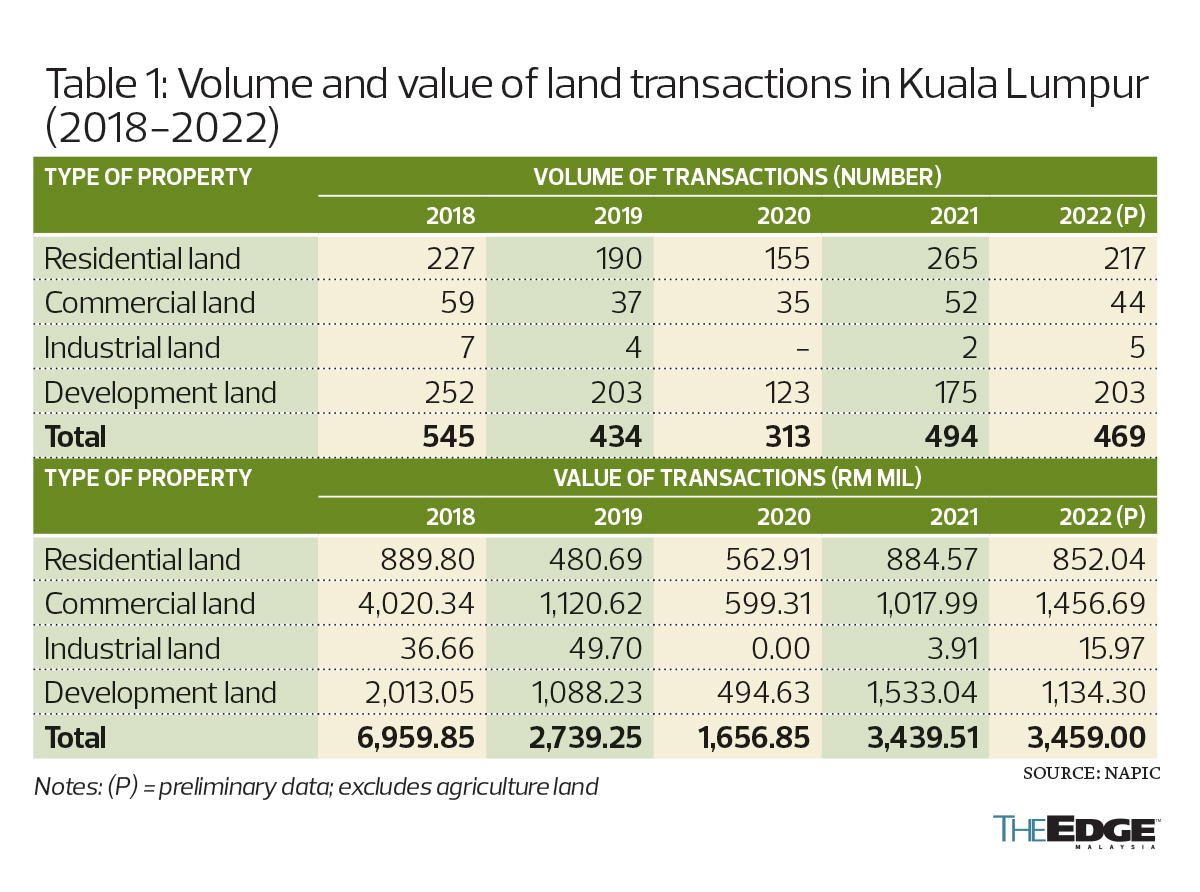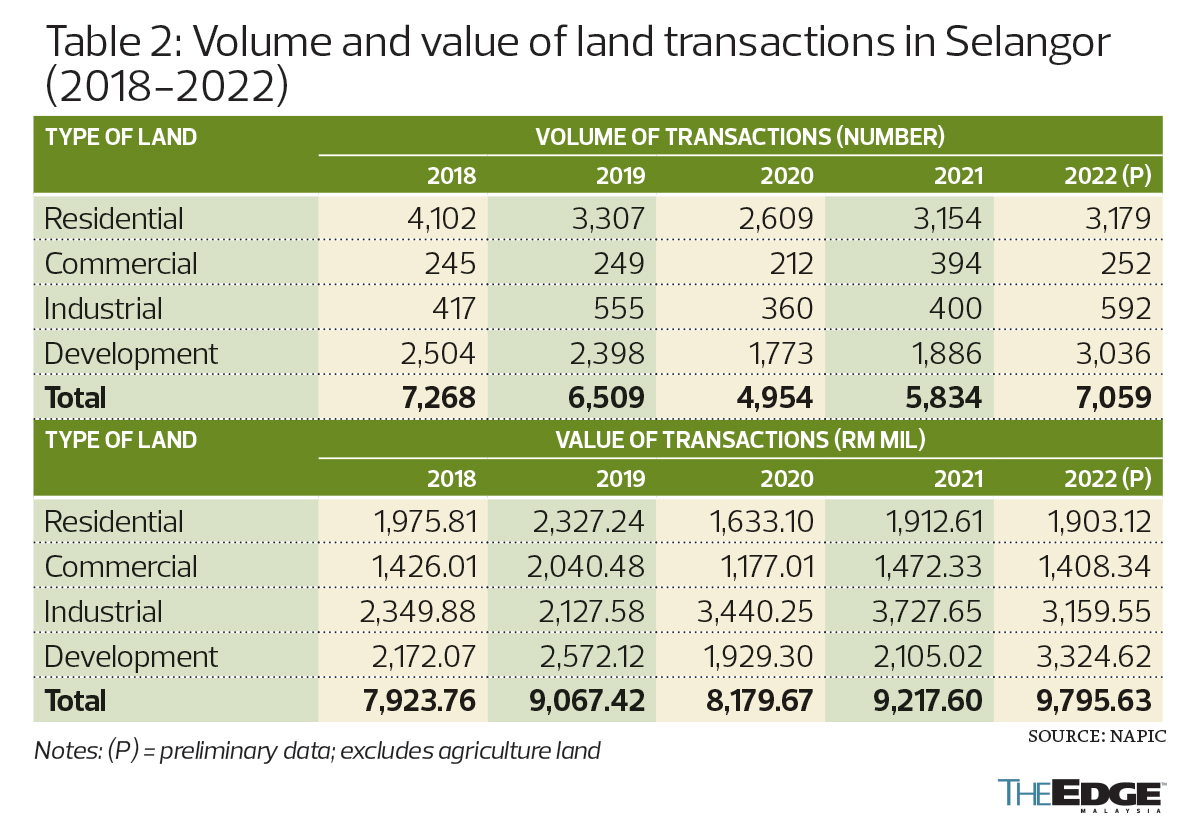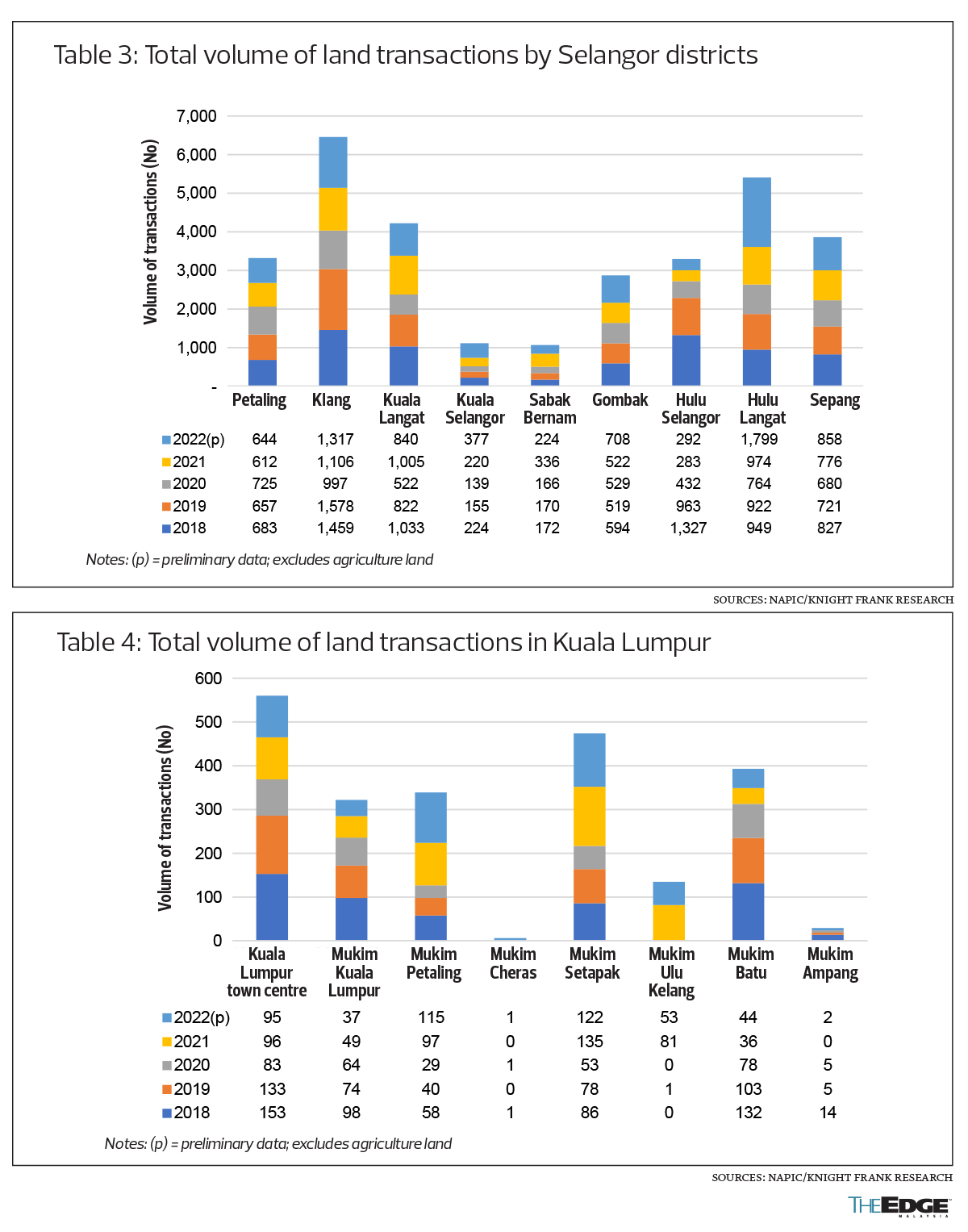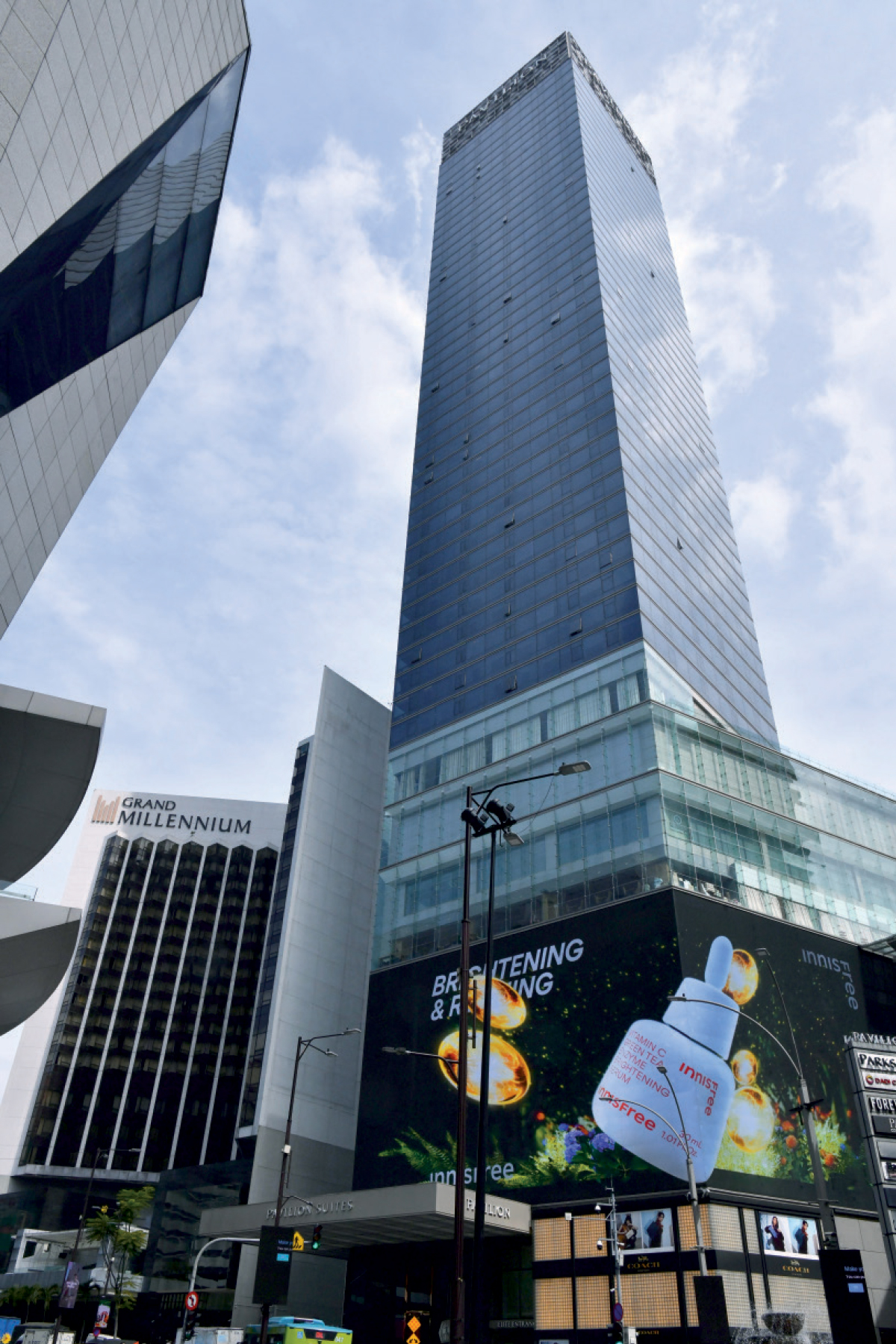
This article first appeared in City & Country, The Edge Malaysia Weekly on July 31, 2023 - August 6, 2023
What makes land unique among all asset types is that it is the only one that does not depreciate in value.
“In the real estate market, land has three physical characteristics: immobility, indestructibility and non-homogeneity,” states CBRE | WTW chairman Foo Gee Jen. “Land prices usually will not depreciate because the asset is considered to have an infinite useful life and is a resource that cannot be replenished.”
This is why, despite economic crises like the Asian financial crisis in 1997, the global financial crisis in 2007 and the recent Covid-19 pandemic, land prices in the Klang Valley continue to appear healthy with moderate growth, which Foo attributes mainly to the scarcity of land.
“Transaction volumes and values in the Klang Valley last year saw a stronger recovery and have maintained an upward trend, particularly within the prime areas. The recovery was fuelled by active market performance and robust capital investment demand. Thus, it is expected to post stable momentum with growing transaction activities this year,” he adds.
Knight Frank executive director of land and industrial solutions Allan Sim agrees that land prices in the Klang Valley have climbed steadily as observed over the last five years due to rapid urbanisation and scarcity of land, not to mention the development of road and highway infrastructure and urban rail systems such as the MRT Kajang and Putrajaya Lines, the KTM Skypark Line and the ongoing LRT Bandar Utama-Klang line.
Both Foo and Sim concur that the Covid-19 pandemic disrupted transaction activities in 2020 but the market generally picked up in 2021.
Referring to Table 1, Sim says that the onset of the health crisis in 2020 led to a further decline in transactional activity with 313 transactions valued at RM1.6 billion, down from 434 transactions with a corresponding sales value of RM2.7 billion in 2019. In comparison, 2018 saw 545 transactions with a collective sales value of RM6.9 billion.
Market activity improved in 2021 and 2022, registering 494 and 469 transactions with corresponding values of RM3.439 billion and RM3.459 billion respectively, he notes. “The country’s transition to the endemic phase since April 2022 has led to a gradual recovery in the economy and property market.”
In Selangor, 2018 registered 7,268 land transactions with a collective value of RM7.9 billion, says Sim. “In 2019, a slowdown in market activity led to 6,509 transactions, albeit with a higher sales value of RM9 billion, indicating that higher-valued lands changed hands during the year. The onset of the Covid-19 pandemic in 2020 led to a sharp decline in transactional activity with 4,954 transactions valued at RM8.1 billion in 2020.”
Similar to the Kuala Lumpur market, market activity in Selangor improved to register 5,834 and 7,059 transactions in 2021 and 2022 respectively since the country’s transition to the endemic phase (see Table 2).
Hotspots and sectors
In terms of land transaction activity, Klang district recorded the highest volume in the Klang Valley over the last five years, except for 2022, when it ranked second after Hulu Langat, says Sim (see Table 3).
“Klang, an industrial hotspot, has seen rapid growth in its industrial parks. These include the Bukit Raja Industrial Park, Pulau Indah Industrial Park, Bandar Sultan Suleiman and Perdana Industrial Park, to name a few. It is also home to Port Klang, the second-largest port in Southeast Asia and also one of the world’s busiest,” he says.
As for Hulu Langat district, which is made up of seven Mukims (Ampang, Beranang, Cheras, Hulu Langat, Hulu Semenyih, Kajang and Semenyih), Sim says it witnessed a surge in the total volume of land transactions in 2022. “Generally, all land subsectors contributed to the increase as the number of commercial, industrial and development land transactions increased by about twofold year on year. During the review period from 2018 to 2022, residential and development lands were the main contributors to the high volume of land transactions in the district.
“Additionally, the majority of the developable area (excluding forest land and water bodies) within Hulu Langat district is zoned for residential use and thus residential development in this district has been really active. The locales of Bangi, Semenyih and Beranang are examples of areas that have seen rapid residential developments in recent years,” he adds.
By sector, industrial appears to be a silver lining in the country’s property market, Sim says. “The industrial sector has seen steady growth in recent years largely due to the higher e-commerce penetration rate, resulting in additional warehousing space requirements to meet the surge in last-mile delivery as well as the structural shift towards omnichannel retailing amid the prolonged pandemic. This growing demand is also attributed to the US-China trade war and the ongoing Russia-Ukraine war. The momentum augurs well for industrial-centric areas such as Klang.”
In 2019, 555 industrial land transactions valued at RM2.1 billion in Selangor were recorded, he notes. “Impacted by the strict containment measures in 2020 [due to the Covid-19 pandemic], sales volume declined sharply although a higher sales value was recorded with 360 transactions worth RM3.4 billion — signifying higher-value industrial land changing hands. Market activity picked up in 2021 and 2022, registering 400 and 592 transactions with corresponding transacted values of RM3.7 billion and RM3.1 billion respectively.
“Notably, the average price per transaction for industrial land in the Klang and Petaling districts, which are Klang Valley hotspots, has shown robust growth from 2019 to 2021 with increasing demand resulting from supply chain disruptions as well as the influx of strategic relocation of last-mile assembly plants of multinational operations in multiple countries or regions to mitigate geopolitical risks. The pace of growth, however, has slowed post-pandemic.”
Going into 2022, CBRE | WTW’s Foo observes that land transactions were mainly industrial-focused. “These are industrial lands with factories mainly to the west and south of the Klang Valley. Areas like Bukit Raja, Shah Alam, Klang and Kuala Langat are attracting more interest from investors for industrial properties. For instance, Klang posted the highest transaction values for industrial lands, with five significant transactions totalling RM151 million.”
Additionally, he says developers are actively acquiring new land bank for residential development in Semenyih, Rawang, Subang Jaya and Kuala Lumpur.
“In the first quarter of the year, it is observed that developers are restrategising and accumulating land banks in established areas. Land sales are quite a growing trend among developers seeking to strategically expand their land bank and strengthen future pipeline project launches.”
According to Sim, sales of development land in Selangor, which recorded 2,504 transactions valued at RM2.1 billion in 2018, declined marginally to 2,398 transactions in 2019. “Market activity for this subsegment continued to remain lacklustre in 2020 and 2021 with 1,773 and 1,886 transactions respectively. Post-pandemic, there is a strong uptick in market activity — registering 3,036 transactions with a collective value of RM3.3 billion.”
As for commercial land in Selangor, he says that the sales volume has been fairly consistent from 2018 to 2022, ranging from about 210 to 250 transactions annually. There was a sharp uptick in 2021, with 394 transactions collectively valued at RM1.4 billion.
As for residential land in Selangor, the transaction volume has continued to decline after 2018 and was at its lowest in 2020 with only 2,609 recorded transactions, following the onset of the pandemic and strict containment measures.
“Market activity picked up in 2021 and 2022 but the sales volume has yet to return to the pre-pandemic era. The sales value depicts a similar trend,” he says.
Compared to Selangor, the total volume of land transactions in Kuala Lumpur is relatively lower, according to Sim. “With the high land cost and scarcity of vacant land coupled with the oversupplied market in selected property subsectors, more developers are exploring land banking in the fringe areas/suburbs and Selangor.” (See Table 4).
On prices, Knight Frank’s in-depth analysis of vacant industrial land in Pulau Indah, Kapar and Telok Gong revealed that between 2018 and 2022, the average transacted land prices for the selected localities were on an upward trajectory in general, albeit registering a slight dip in 2019 for Telok Gong and Pulau Indah.
“It is noteworthy that the average transacted prices of industrial land in the selected localities under review continued their uptrend in 2022 and surpassed that in 2018,” Sim remarks.
According to CBRE | WTW’s Foo, transacted land prices in Shah Alam’s Section 15 increased about four to five times over a 10-year period, from transacted prices of RM30 to RM50 psf in 2010 to around RM120 to RM140 psf from 2020 to 2022.
“Section 15 Shah Alam is one of the more established and highly sought-after areas for industrial and logistics developments in the Klang Valley. Limited land availability has increased the value of properties in the area. We anticipate further unlocking of value within the area by acquisition activities.”
Township development land in Rawang also saw prices more than double in five to seven years, says Foo, from about RM6 to RM7 psf in 2012 to around RM17 to RM20 psf between 2017 and 2019. Similar trends were observed in Semenyih with land transacted at around RM6 to RM8 psf in 2010 to about RM15 to RM18 psf in 2020 to 2022, he adds.
Notable transactions and record prices
A notable land transaction in the Klang Valley is the leasehold industrial land in Section 15 Shah Alam from UMW Holdings Bhd to Mapletree Dextra Pte Ltd for a consideration of about RM287.7 million in 2018.
“This deal, which was brokered by CBRE | WTW, is an example of unlocking the value of the existing site into a logistics hub in Shah Alam,” says Foo.
Another two notable transactions concluded in 2020, as Foo highlights, were the 154ha under the sea for the port terminal extension, acquired by Westports Holdings Bhd for RM116.9 million and the 212-acre The Compass integrated industrial park by the AREA Group from PNB Development for about RM330 million.
“The Compass will be the largest new modern integrated, gated-and-guarded industrial park, strategically located at one end of the ongoing West Coast Expressway,” says Foo.
Last year, J&T Express acquired a 30-acre plot in Bandar Rimbayu for RM600 million to meet its growing logistical needs. “The same year, Sime Darby paid RM618 million for a 948-acre plot in Kapar with the intention of developing an integrated sustainable industrial township.
“The dominance of industrial land was mainly due to rezoning to a higher usage of mixed commercial use and pent-up demand from logistical and warehouse requirements driven by the Covid-19 pandemic,” Foo explains.
In terms of record prices, Foo says the Bukit Bintang and KL city centre areas are known for having the highest transacted land prices in the Klang Valley. At Tun Razak Exchange (TRX), for example, HSBC acquired a land parcel for RM227 million, or RM4,131 psf, in 2017, and Core Precious Development acquired another for RM223 million, or RM3,097 psf, in 2015.
Also in TRX, Affin Holdings Bhd reportedly purchased approximately 1.25 acres for the construction of its new headquarters at RM4,699.07 psf back in 2015, while Mulia Group acquired another parcel measuring 3.42 acres for RM4,463.83 psf in the same year, says Sim.
Nevertheless, the highest transacted land price is still the site of Pavilion Elite, note the consultants. The land parcel measuring 29,127 sq ft, located between Grand Millennium KL Hotel and Pavilion Kuala Lumpur, was acquired by Urusharta Cemerlang (KL) Sdn Bhd at a record price of RM210 million, or about RM7,209.80 psf, in 2010.
These deals mark some of the highest land prices transacted on a psf basis in the Klang Valley, says Sim. “Notably, these parcels are in a prime location, some within the capital city’s upcoming financial district, with a high plot ratio, infrastructure readiness and incentives.” (See Table 5 for more notable transactions over the last five years).
Favourable outlook
In the near to mid-term, Sim expects more land banking activities in selected locales and upcoming hotspots including those along the existing and new rail routes.
“The overall outlook for land prices in the Klang Valley remains one of cautious optimism in the medium to longer term, backed by its central location, growing population and urbanisation, and stable economic growth. While the overall property market activity was generally subdued during the Covid-19 pandemic, industrial land prices in Klang Valley have continued on an upward trend as Malaysia is set to be one of the beneficiaries of the ongoing major restructuring of global supply chains arising from the aftermath of the pandemic, the US-China trade war and the ongoing Russia-Ukraine war, among other factors. Post-Covid-19, more major companies may be looking for ways to diversify and decentralise their supply chains,” he says.
“Similarly, industry shifts in the retail segment due to changes in consumer shopping behaviour — some permanent — have led to the flourishing of the e-commerce industry. Many business-to-consumer firms are quickly adapting to online retailing services and this has also led to higher demand for warehousing space.
“The formation of the new unity government coupled with favourable policy support will help Malaysia attract more foreign and domestic direct investments, which is positive for the country’s continued economic expansion and property market recovery,” he adds.
Meanwhile, Foo says that infrastructure is the main catalyst in terms of land value enhancement.
“Highways, expressways and transport options available such as the LRT and MRT have created added value for real estate close to those projects. The latest West Coast Expressway project has also shown how infrastructure has enhanced the value of land in Ijok, Kapar and Kuala Langat, for example.
“The projects have spurred industrial and logistics players to acquire land nearby as development facilitates connectivity to ports and airports. The opening of industrial development may also stimulate demand for housing and commercial development in those areas.”
Foo adds that the presence of a growth enhancer like IDRISS — an integrated development region in south Selangor — is expected to stimulate investment and spur development initiatives within the state by leveraging the incentives offered by its government.
“Spanning across 20,000 ha in Sepang and Kuala Langat and with a projected gross development value worth RM1 trillion, IDRISS promises massive economic prospects for investors.
“Improvement of the infrastructure and new incentives offered in the Klang Valley will open up development opportunities, especially outside the city area. Thus, we anticipate that land prices will appreciate further in the future,” he concludes.
Save by subscribing to us for your print and/or digital copy.
P/S: The Edge is also available on Apple's App Store and Android's Google Play.








